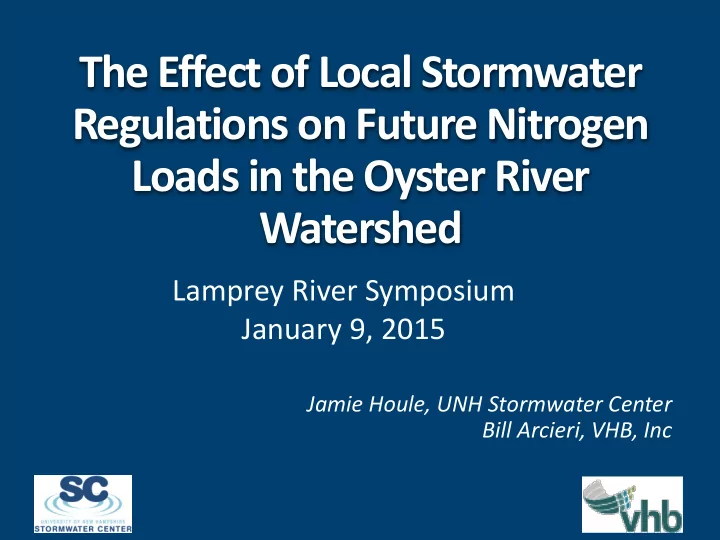

The Effect of Local Stormwater Regulations on Future Nitrogen Loads in the Oyster River Watershed Lamprey River Symposium January 9, 2015 Jamie Houle, UNH Stormwater Center Bill Arcieri, VHB, Inc
Pollution Prevention Grant provided by EPA Region 1 Project team includes UNHSC VHB SRPC
Core Elements: Promotes LID Planning and “Green Infrastructure” Groundwater Recharge and Volume Control Addresses existing IC through redevelopment requirements Requires Operations and Maintenance
Adapted from Schueler
Major Steps; Build-Out Analysis to Estimate Future IC Increases. How Much of Future IC Area would be Subject to New Regulations. How Much of the Applicable IC Area would be Treated due to New Regulations. Assume a Typical Pollutant Removal Efficiency for Stormwater BMP Treatment
Major Assumptions: Based on Population Growth & Current IC per capita ratio in each Town. Population Growth Estimates Available for 2025 and 2040 (30 years). For Durham & Dover, 80% of the future development would occur as subdivisions or multi- family units and subject to new regulations. For other towns, 50:50 split as subdivisions/multi- family and single-lot development.
500 450 400 350 300 250 Acres 200 150 100 50 0 Barrington Dover Durham UNH Lee Madbury Nottingham Total Existing Commercially Developed Land Estimated Future Commercial Developed Area based on 20% Assumption SRPC Priority Commercial Properties for Future Development
Major Assumptions: Statistics for existing commercial developments in Durham that would Future IC Area based on be subject to regulation Current IC per Parcel Ratio Trigger % Regulated Load reductions based on Condition (sf) trigger condition 5,000 80% 10,000 60% 80 % of the Future 20,000 50% Commercial Dev. Subject to 40,000 30% Regs
Pollutant Loading per Impervious Acre (lbs/ac/yr) Base Load Rate TSS TP TN Residential 266 1.6 16.1 Commercial 613 2.6 23.6 Load Rate with Treatment* & Regs adopted Residential 34.5 0.73 6.4 Commercial 79.6 1.18 9.5 *assumes 87%, 55%, 60% removal rates Loading rates based on USEPA Simple Method
Projected Increase in IC Area (acres) TOTALS 6 NOTTINGHAM Durham and UNH account for 70% MADBURY 24 of future projected IC area LEE 28 increases UNH 99 DURHAM 262 DOVER 52 BARRINGTON 39 0 100 200 300 400 500
Based on assumption that 25% of the Commercial IC area is redeveloped
You keep using the words “pollutant load reduction”, I am not sure it means what you think it means…
3,094 8 82
Total Watershed Cost = $13.6 million Exclude MS4 Towns = $2.6 million Assumes an average treatment cost of $30,000 per acre. Costs are in 2015 dollars
Recommend
More recommend